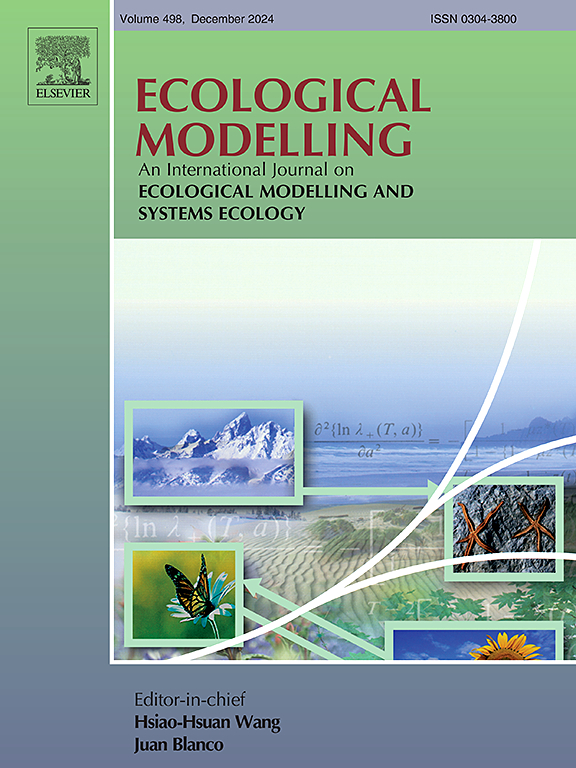高度专门化个体的通才物种?
IF 2.6
3区 环境科学与生态学
Q2 ECOLOGY
引用次数: 0
摘要
生态位和物种-环境关系都是当代生态科学的基石。已实现的生境生态位定义了物种发生、适应和繁荣的条件,物种-环境关系的量化是描述已实现生境生态位的一种手段。在分析物种与环境的关系和生态位时,一个经常出现的假设是,物种与其环境之间存在着一种共同的、固定的和稳定的关系。此外,这意味着这种关系适用于整个物种,或者更确切地说,适用于物种的所有个体。然而,生态科学的另一个基石是种群,甚至个体,在遗传特征和塑造其行为的环境影响方面是不同的。因此,种-环境关系和实现的生境位可能在种内发生变化。在不同生态环境下行为的一致性或对空间变化的限制因素作出反应的基因同质性是应该调查和检验的假设。本文以苏格兰的欧洲野猫(Felis silvestris)与家猫(F.catus)杂交为例,探讨了生态建模者所称的非平稳栖息地使用,以及野外生态学家所称的个体变异,或者从进化的角度来看,种内变异。本文分析了分布在苏格兰的14个野猫杂交个体的发生模式和生态响应曲线,以评估在多个环境变量中栖息地关联表达模式的个体变异程度。我们提出了三个概念模型,对应于样本种群栖息地关联的三种不同模式:平稳通才型、平稳专才型和非平稳专才型。每种野猫杂交生境选择假说都对环境变量响应曲线的形状和重叠,以及个体间使用生境和可用生境的重叠程度有独特的期望。我们能够在我们的小但地理上广泛的样本中显示出高度的个体异质性和专业化。我们的研究结果支持了一种假设,即苏格兰的野猫杂交是不稳定的栖息地专家。即在个体水平上,野猫杂交种的生境关联具有高度的异质性,跨个体的汇总分析不能完全反映个体响应的范围或变异,也不能反映任何个体的实际生境选择响应曲线。这提供了一个令人信服的例子,说明在单一物种中栖息地联系的高度可变和异质性。我们的研究结果支持了最近的其他研究,这些研究表明,物种对现有条件具有当地适应性。本文章由计算机程序翻译,如有差异,请以英文原文为准。
A generalist species of highly specialized individuals?
The ecological niche and the species-environment relationship are both cornerstones of contemporary ecological science. The realized habitat niche defines the conditions in which a species occurs, is adapted and can thrive, and quantification of the species-environment relationship is a means to describe the realized habitat niche. A frequent, if unspoken, assumption in analyses of species-environment relationships and the ecological niche is that there is a common, stationary and stable relationship between a species and its environment. This implies, additionally, that this relationship applies to the species as a whole, or rather to all individuals of the species. However, another cornerstone of ecological science is that populations, and even individuals, differ in their genetic characteristics and the environmental influences that shape their behavior. Therefore, the species-environment relationship and the realized habitat niche are likely to vary intra-specifically. Uniformity in behaviour under different ecological circumstances or genetic homogeneity in response to spatially varying limiting factors are assumptions that should be investigated and tested. In this paper, using European wildcat (Felis silvestris) x domestic cat (F.catus) hybrids in Scotland as a policy-relevant exemplar, we explore what ecological modellers call nonstationary habitat use, and what field ecologists call individual variation, or, with an evolutionary perspective, intra-specific variation. We analyze the occurrence patterns and ecological response curves of 14 individual wildcat hybrids distributed across Scotland to assess how much individual variation there is in expressed patterns of habitat association across multiple environmental variables. We propose three conceptual models corresponding to three divergent patterns of habitat association for the sampled population: stationary generalist, stationary specialist, and nonstationary specialist. Each of these alternative hypotheses of habitat selection for wildcat hybrids had unique expectations for the shape and overlap of response curves along environmental variables, and for the degree of overlap between used and available habitat among individuals. We were able to show a high degree of individual heterogeneity and specialization across our small but geographically widespread sample. Our results support the hypothesis that wildcat hybrids in Scotland are nonstationary habitat specialists. That is, the habitat associations of wildcat hybrids are highly heterogeneous at an individual level, and that pooled analyses across individuals fails to completely represent the range or variation of individual responses, and also fails to represent the actual habitat selection response curves of any individual. This provides a compelling example of the highly variable and heterogenous nature of habitat association within a single species. Our results support other recent studies where species demonstrate local adaptations to available conditions.
求助全文
通过发布文献求助,成功后即可免费获取论文全文。
去求助
来源期刊

Ecological Modelling
环境科学-生态学
CiteScore
5.60
自引率
6.50%
发文量
259
审稿时长
69 days
期刊介绍:
The journal is concerned with the use of mathematical models and systems analysis for the description of ecological processes and for the sustainable management of resources. Human activity and well-being are dependent on and integrated with the functioning of ecosystems and the services they provide. We aim to understand these basic ecosystem functions using mathematical and conceptual modelling, systems analysis, thermodynamics, computer simulations, and ecological theory. This leads to a preference for process-based models embedded in theory with explicit causative agents as opposed to strictly statistical or correlative descriptions. These modelling methods can be applied to a wide spectrum of issues ranging from basic ecology to human ecology to socio-ecological systems. The journal welcomes research articles, short communications, review articles, letters to the editor, book reviews, and other communications. The journal also supports the activities of the [International Society of Ecological Modelling (ISEM)](http://www.isemna.org/).
 求助内容:
求助内容: 应助结果提醒方式:
应助结果提醒方式:


